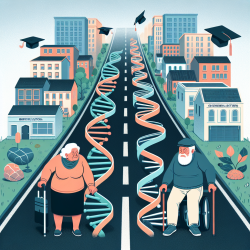Introduction
The recent study titled "Phenotype Genotype Characterization of FKRP-related Muscular Dystrophy among Indian Patients" by G. Unnikrishnan et al. offers valuable insights into the genetic and phenotypic spectrum of FKRP-related muscular dystrophies. This research provides a comprehensive overview of the clinical presentations and genetic mutations associated with this condition, particularly among Indian patients. As practitioners, understanding these findings can significantly enhance diagnostic accuracy and patient management strategies.
Key Findings
The study highlights the variability in clinical presentations of FKRP mutations, which include limb girdle muscular dystrophy (LGMD) R9 and congenital muscular dystrophies. A notable finding is the prevalence of the c.1343C>T mutation in the cohort, which was present in five patients. Additionally, four novel mutations were identified, underscoring the genetic diversity of this condition.
Patients exhibited a range of symptoms, including delayed motor milestones, calf muscle hypertrophy, and facial weakness. The study also noted a Duchenne-like phenotype as the most common presentation, with a tendency for early loss of ambulation.
Implications for Clinical Practice
For practitioners, these findings emphasize the importance of considering FKRP mutations in patients presenting with muscular dystrophy symptoms, particularly those resembling Duchenne muscular dystrophy. The identification of common and novel mutations can guide genetic testing and counseling, ensuring accurate diagnosis and tailored treatment plans.
Practitioners should also be aware of the potential for early loss of ambulation and the need for proactive management strategies to support mobility and quality of life. Regular monitoring of cardiac and respiratory function is crucial, given the potential for involvement in later stages of the disease.
Encouraging Further Research
This study opens avenues for further research into the genetic underpinnings of FKRP-related muscular dystrophies. Practitioners are encouraged to contribute to ongoing research efforts by documenting clinical cases and sharing genetic data. Collaborative research can enhance our understanding of the disease and lead to the development of targeted therapies.
Conclusion
The research by Unnikrishnan et al. is a valuable resource for practitioners dealing with muscular dystrophies. By integrating these findings into clinical practice, practitioners can improve diagnostic accuracy and patient outcomes. Continued research and collaboration are essential for advancing our understanding and treatment of FKRP-related muscular dystrophies.
To read the original research paper, please follow this link: Phenotype Genotype Characterization of FKRP-related Muscular Dystrophy among Indian Patients.










